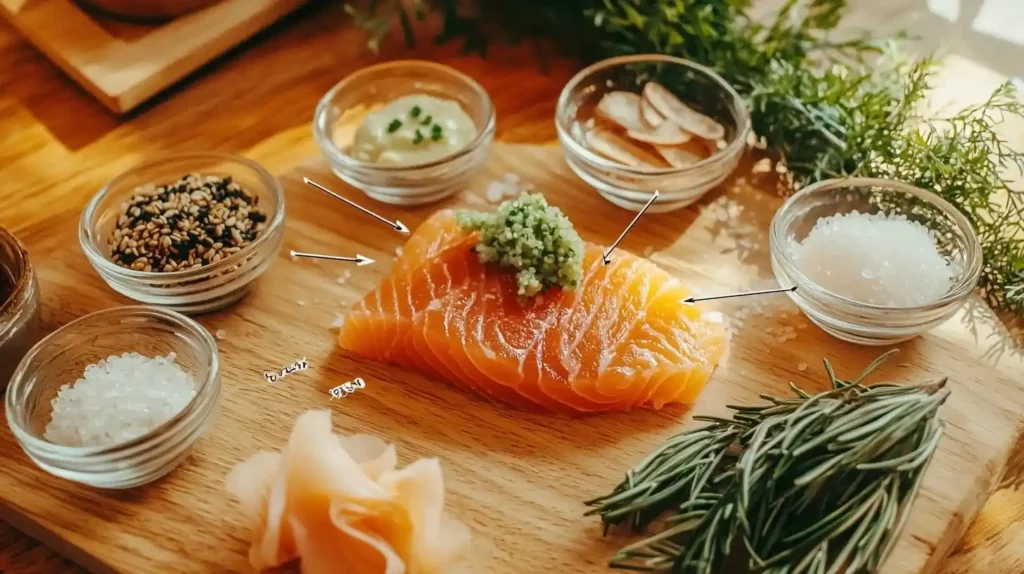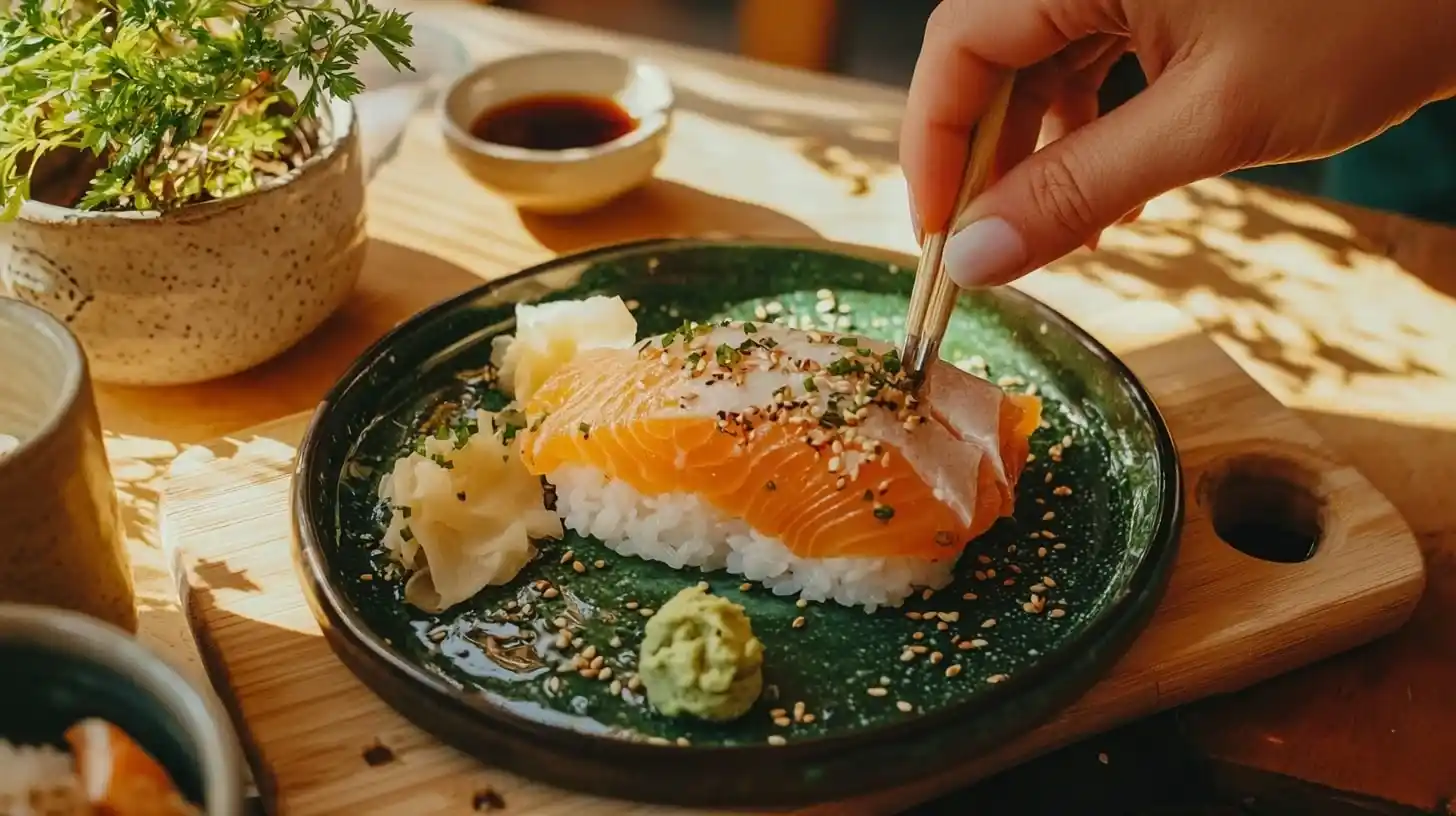“How would you describe that taste?” My seven-year-old’s question caught me off guard as he watched me savor a piece of Salmon Nigiri during his first visit to a Japanese restaurant. Finding words for this distinct culinary experience proved surprisingly challenging.What does salmon nigiri taste like?
Salmon nigiri offers a unique flavor profile that balances several taste elements in perfect harmony. This deceptively simple dish combines buttery fish, seasoned rice, and subtle seasonings to create a distinctive taste experience that has made it one of the most approachable and beloved Japanese delicacies worldwide.
My family’s exploration of Japanese cuisine began with salmon nigiri precisely because its flavor profile provides an accessible entry point for those new to raw fish preparations. Understanding what makes this dish special enhances appreciation for its subtle complexity.
Table of Contents
What does salmon nigiri taste like?The Complete Flavor Experience

Show Main Image Salmon nigiri’s visual appeal hints at its flavor experience – the translucent, buttery fish balanced by perfectly seasoned rice creates a harmonious bite!
The overall flavor profile of salmon nigiri is best described as:
Delicate yet distinct, with subtle sweetness from both the fish and rice.
Clean and fresh, with oceanic notes that should never be overpoweringly “fishy.”
Buttery and rich, with the natural oils in salmon creating a smooth mouthfeel.
Balanced by the gentle vinegar acidity in the rice, creating perfect counterpoint.
Mildly savory (umami), particularly when dipped lightly in soy sauce.
For those wondering about the raw aspect, Is salmon nigiri raw? explains that the traditional preparation does feature raw salmon, which significantly influences its distinctive taste and texture.
For more globally-inspired culinary experiences, explore our International Lunch Inspirations: Global Flavors Made Simple collection, which features accessible international dishes for family meals.
Breaking Down the Taste Components
Show Flavor Components Image The flavor symphony of salmon nigiri broken down: five distinct components that combine to create its characteristic taste experience!
Several elements contribute to salmon nigiri’s distinctive flavor:
The Salmon: Offers natural sweetness, buttery richness, and subtle oceanic notes. Premium salmon has a clean taste without fishy overtones that many first-time tasters appreciate.
The Rice: Provides a foundation of subtle sweetness and gentle vinegar tang that balances the fish. My daughter calls this “happy rice” because of its delicate flavor enhancement.
Wasabi: Contributes controlled heat that clears the palate without overwhelming when used properly. Traditional nigiri includes a small dab between rice and fish.
Natural Brine: Fresh salmon contains natural salinity that enhances its flavor without requiring additional salt.
Umami: Both fish and rice contribute savory depth that creates satisfaction beyond basic taste components.
For those curious about other Japanese fish preparations, What is nigiri vs sashimi? explains how the absence of rice in sashimi creates a different taste experience focused exclusively on the fish.
Texture: An Essential Element
Texture plays a crucial role in the salmon nigiri experience:
The Fish: Offers a smooth, silky mouthfeel that melts slightly with body temperature. My husband, initially reluctant to try raw fish, was won over by this luxurious texture.
The Rice: Provides a gentle resistance that contrasts with the fish. Properly prepared sushi rice holds together while maintaining distinct grains that separate easily in the mouth.
Temperature Contrast: Room temperature fish against slightly warm rice creates subtle temperature variation that enhances perception of both flavor and texture.
The textural interplay between components is what makes nigiri distinct from other sushi styles. My youngest son describes it as “fish that melts like butter on top of little pillows of rice.”
For comprehensive meal ideas beyond Japanese cuisine, our Family-Friendly Lunch Recipes: Effortless Meals for Busy Parents collection offers additional inspiration.
Accompaniments That Enhance the Flavor
Traditional accompaniments modify the base flavor of salmon nigiri:
Soy Sauce: When lightly applied, adds saltiness and additional umami depth. The traditional technique involves turning the nigiri fish-side down for a gentle dip that doesn’t oversaturate the rice.
Pickled Ginger: Used as a palate cleanser between pieces rather than eaten simultaneously. My children initially misunderstood this, creating some amusing flavor combinations before learning its proper purpose.
Additional Wasabi: While traditional nigiri contains wasabi between fish and rice, some prefer adding more for personalized heat level.
These accompaniments should enhance rather than mask the primary flavors. My grandmother wisely noted after her first nigiri experience, “Good fish needs little decoration” – a principle that applies perfectly to quality salmon nigiri.
For those interested in the nutritional aspects of this delicacy, Is Salmon Nigiri Healthy for You? examines how this flavorful bite also offers impressive nutritional benefits.
First-Time Tasting Expectations
First-time salmon nigiri tasters often experience:
Surprise at the mild, approachable flavor that lacks the “fishiness” many expect from raw preparations.
Appreciation for the rich, buttery quality that makes salmon particularly accessible for newcomers to Japanese cuisine.
Delight in the temperature and textural contrast between fish and rice.
Satisfaction from the complete flavor profile that combines sweetness, umami, and subtle acidity in one bite.
My sister, initially resistant to trying raw fish, described her first taste as “nothing like I expected – much cleaner, fresher, and more delicate.”
Answers to Your Flavor Questions
Does high-quality salmon nigiri taste different from budget options? Absolutely – premium salmon offers more distinct sweet notes, cleaner flavor, and superior texture. My first experience with truly high-quality salmon nigiri revealed flavor nuances absent in budget sushi restaurant versions.
Is frozen salmon nigiri less flavorful than fresh? Properly flash-frozen and defrosted fish can maintain excellent flavor, and most “fresh” sushi fish has actually been previously frozen for safety. The most significant flavor factors are fish quality and handling rather than freezing status.
Why does restaurant salmon nigiri taste different from homemade? Restaurant preparation often benefits from specialized rice preparation techniques, fish aging methods, and precise knife skills that enhance flavor and texture. My homemade versions improved significantly after studying traditional rice seasoning techniques.
Creating the Authentic Taste at Home
Several factors help create authentic salmon nigiri flavor at home:
Source proper sushi-grade salmon from reputable fishmongers who understand raw fish preparation requirements.
Master proper rice preparation, including correct vinegar seasoning proportions and temperature.
Use gentle hand pressure when forming rice – compressing too firmly creates dense texture that affects flavor perception.
Serve at the proper temperature – never directly from refrigeration, as cold suppresses flavor nuances.
My family’s nigiri-making sessions involve all these elements, with each family member developing preferences for specific rice seasoning levels and wasabi amounts.
The distinctive taste of salmon nigiri represents Japanese cuisine’s elegant simplicity – a few quality ingredients prepared with respect and precision to create harmony greater than the sum of its parts.
With warmth, Sophia





